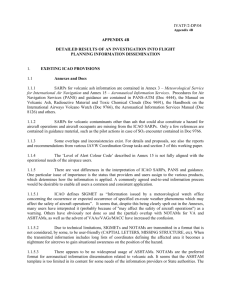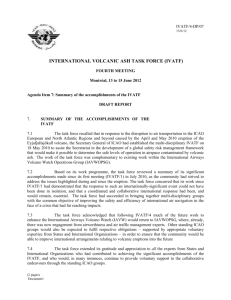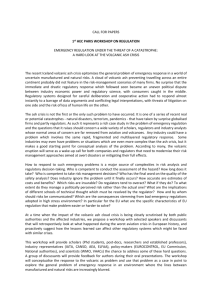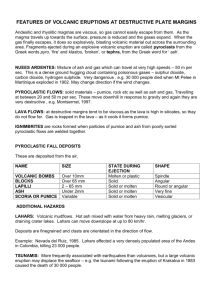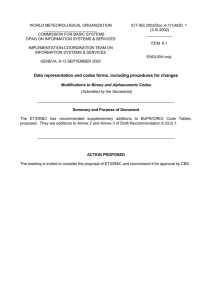1 - WMO
advertisement
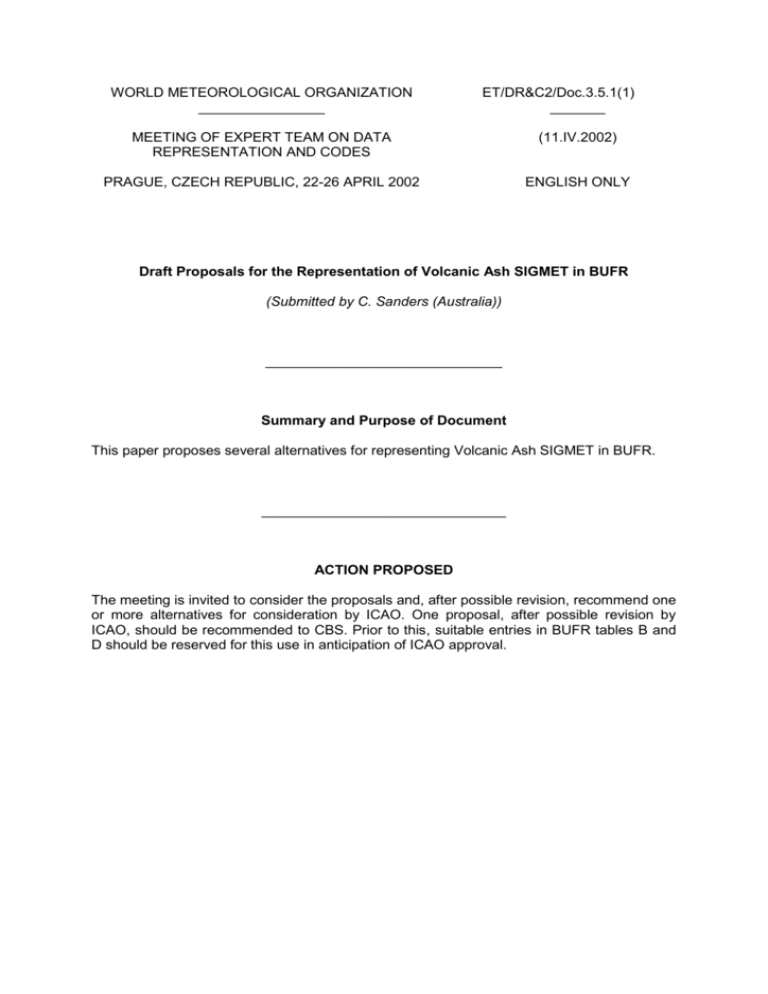
WORLD METEOROLOGICAL ORGANIZATION ________________ ET/DR&C2/Doc.3.5.1(1) _______ MEETING OF EXPERT TEAM ON DATA REPRESENTATION AND CODES (11.IV.2002) PRAGUE, CZECH REPUBLIC, 22-26 APRIL 2002 ENGLISH ONLY Draft Proposals for the Representation of Volcanic Ash SIGMET in BUFR (Submitted by C. Sanders (Australia)) ______________________________ Summary and Purpose of Document This paper proposes several alternatives for representing Volcanic Ash SIGMET in BUFR. _______________________________ ACTION PROPOSED The meeting is invited to consider the proposals and, after possible revision, recommend one or more alternatives for consideration by ICAO. One proposal, after possible revision by ICAO, should be recommended to CBS. Prior to this, suitable entries in BUFR tables B and D should be reserved for this use in anticipation of ICAO approval. ET/D&RC/Doc.3.5.1(1), p. 2 DISCUSSION 1. Background Amendment 72 to ICAO Annex 3, WMO Technical Regulation - [C.3.1] – Meteorological Service for International Air Navigation recommends Meteorological watch offices in a position to do so should issue SIGMET information for volcanic ash cloud and tropical cyclones in graphical format using the WMO BUFR code. This paper addresses the BUFR table changes required to issue volcanic ash cloud SIGMET in the BUFR code form and discusses a number of possible coding sequences. If the BUFR descriptors are carefully chosen, it should be possible to extend the encoding of Volcanic Ash SIGMET to other SIGMET. Several details will need clarification before any proposals can be finalised. These include The number of layers of Volcanic ash specification required, Whether or not there is a requirement for the inclusion of the Volcano summit height Whether a single direction and speed of motion will be adequate, or if motion and intensity changes are required for the forecasts and outlooks 2. Table B entries The encoding of Volcanic Ash SIGMET in BUFR will require a number of new Table B entries. The proposed new entries are listed in appendix A. 3. Table D entries Although not strictly necessary, the encoding of Volcanic Ash SIGMET in BUFR will be simplified if sequence descriptors are defined for major parts of the message. The sequence descriptors will depend on ICAO preferences, and cannot be finalised at this time. Possible new descriptors are listed in appendix B. The examples have provision for multiple layers as ICAO has indicated a need for at least two layers. Alternatives are given, for example there is a sequence that allows for separate motion forecasts at each boundary point, and one that only has one overall motion forecast for each layer. 4. Proposed sequences A number of possible sequences are given in Appendix C. These include - A sequence with observation, forecasts and outlook combined in a replication - A sequence with separate parts for the observed cloud, forecasts, and outlook ET/D&RC/Doc.3.5.1(1), p. 3 Appendix A: Proposed Table B entries Table Reference F X Y Element name 0 01 037 0 01 038 0 01 039 0 07 011 0 08 019 0 20 028 SIGMET sequence number FIR or UIR identifier (see note 12) VACC identifier (see note 13) Summit elevation Qualifier for following centre identifier Expected change in intensity BUFR CREX Unit Scale Numeric CCITT IA5 CCITT IA5 M Code table Code table 0 0 0 0 0 0 Reference value 0 0 0 0 0 0 Data width 7 32 32 13 4 3 Remarks Unit Scale Numeric Character Character M Code table Code table 0 0 0 0 0 0 Data width 2 4 4 4 1 1 (1), (4) (1), (5) (2), (6) (3) (3) Notes: (12) The ICAO identification of the flight Information region (FIR), upper information region (UIR) or CTA (Control Area) to which the SIGMET or other advisory applies. (13) The ICAO identification of the volcanic ash advisory centre that is responsible for the advice which has resulted in the issue of this SIGMET or other advisory. Remarks: (Explanatory to proposal, will not be part of Table B) (1) May need to be 8 or 9 characters, 64 or 72 bits. (2) If ultimate accuracy of 1ft is required, will have to be 17 bits, 5 characters, and scale 1 (3) More or fewer bits or characters may be chosen depending on whether how many values are reserved for future use. (4) May not be needed, it may be possible to use either 0 01 062 or 0 01 063. (5) May not be needed, it may be possible to use 0 01 062, 0 01 063, 0 01 033, or 0 01 033 plus 0 01 034. (6) May not be needed, it may be possible to use 0 07 001 or 0 07 007 ET/D&RC/Doc.3.5.1(1), p. 4 Code tables 0 08 019 Qualifier for following centre identifier Code figure 0 Reserved 1 ATC (Air Traffic Control) unit serving FIR (Flight Information Region) 2 FIR (Flight Information Region) 3 UIR (Upper Information Region) 4 CTA (Control Area) 5 VAAC (Volcanic Ash Advisory Centre) 6 Meteorological Watch Office issuing SIGMET 7-14 Reserved 15 Missing value 0 20 028 Expected change in intensity Code figure 0 No change (INTST NC) 1 Forecast to weaken (INTST WKN) 2 Forecast to intensify (INTST INC) 3-6 Reserved 7 Missing value Remarks (7) (8) (9) (9) Remarks (10) Remarks: (Explanatory to proposal, will not be part of the code tables) (7) May not be needed if 0 01 033 (and possibly 0 01 034) is used for issuing office (8) May not be required if ICAO do not need the VACC to be identified in the SIGMET (9) Could use only 3 bits and have 7 = Missing value (10) Could use only 2 bits and have 3 = Missing value ET/D&RC/Doc.3.5.1(1), p. 5 Appendix B: Proposed Table D entries Note that there are several choices for many of these. Not all the following proposed descriptors will be required. ICAO will have to specify the requirements in more detail before the sequences can be finalised. Table Table Element name reference references F X Y 3 16 020 3 16 021 3 16 021 Remarks 0 01 033 0 01 034 1 02 002 3 01 011 3 01 012 0 08 019 0 01 062 0 08 019 0 01 062 0 08 019 0 01 062 0 08 019 (SIGMET header) Originating/Generating Centre Originating/Generating Sub-centre Replication of 2 descriptors two times Year, Month, Day Hour, Minute Qualifier for location identifier, 1=ATC unit serving FIR ICAO location identifier Qualifier for location identifier, 2=FIR, 3=UIR, 4=CTA ICAO location identifier Qualifier for location identifier, 5=VAAC ICAO location identifier Qualifier for location identifier, Missing=Cancel 0 08 011 0 01 022 0 08 007 3 01 024 0 08 021 (Volcanic ash SIGMET, Volcano details) Meteorological feature, 19=Volcanic ash/Special clouds Name of feature Dimensional significance, 0=Point Location and height Time significance, Missing=Cancel (4) ** (4) 0 08 011 0 01 022 0 08 007 3 01 024 0 08 007 0 08 021 3 01 011 3 01 012 0 08 021 (Volcanic ash SIGMET, Volcano details + eruption time) Meteorological feature, 19=Volcanic ash/Special clouds Name of feature Dimensional significance, 0=Point Location and height Dimensional significance, Missing=Cancel Time significance, 17=start of phenomenon Year, Month, Day Hour, Minute Time significance, Missing=Cancel Note**: a new entry would be required in Code Table O 08 011: 19 Volcanic Ash/Special clouds (1) (1) (2) (3) (3) (3) (5) (5) ET/D&RC/Doc.3.5.1(1), p. 6 Table Table Element name reference references F X Y 3 16 022 0 08 021 3 01 011 3 01 012 1 09 000 0 31 001 0 07 002 0 07 002 0 08 007 1 01 000 0 31 001 3 01 023 0 19 005 0 19 006 0 08 007 0 20 090 0 20 028 0 08 021 (Volcanic ash SIGMET, Obs/Fcst area and motion) Time Significance, 16=Analysis, 4=Forecast Year, Month, Day Hour, Minute Replicate 9 descriptors Replication count Flight level (base of cloud) Flight level (top of cloud) Dimensional significance, 2=Area Replicate one descriptor Replication count Latitude, longitude Direction of motion Speed of motion Dimensional significance, Missing=cancel Type of cloud, 5=Volcanic Ash/Eruption Expected change in intensity Time significance, Missing=cancel 3 16 022 0 08 021 3 01 011 3 01 012 1 10 000 0 31 001 0 07 002 0 07 002 0 08 007 1 03 000 0 31 001 3 01 023 0 19 005 0 19 006 0 20 028 0 08 007 0 20 090 0 08 021 (Volcanic ash SIGMET, Obs/Fcst area and motion) Time Significance, 16=Analysis, 4=Forecast Year, Month, Day Hour, Minute Replicate 10 descriptors Replication count Flight level (base of cloud) Flight level (top of cloud) Dimensional significance, 2=Area Replicate 3 descriptors Replication count Latitude, longitude Direction of motion Speed of motion Expected change in intensity Dimensional significance, Missing=cancel Type of cloud, 5=Volcanic Ash/Eruption Time significance, Missing=cancel Remarks (6) (6) ET/D&RC/Doc.3.5.1(1), p. 7 Table Table Element name reference references F X Y 3 16 023 0 08 021 3 01 011 3 01 012 1 07 000 0 31 001 0 07 002 0 07 002 0 08 007 1 01 000 0 31 001 3 01 023 0 08 007 0 20 090 0 08 021 (Volcanic ash SIGMET, Forecast/outlook) Time Significance, 4=Forecast Year, Month, Day Hour, Minute Replicate 7 descriptors Replication count Flight level (base of cloud) Flight level (top of cloud) Dimensional significance, 2=Area Replicate one descriptor Replication count Latitude, longitude Dimensional significance, Missing=cancel Type of cloud, 5=Volcanic Ash/Eruption Time significance, Missing=cancel Remarks (7) Remarks (explanatory to proposal, will not be part of table D) (1) Could be replaced with some other identification, such as 0 01 062, 0 08 019 and 0 01 062, or other combinations. (2) Could be replaced with a longer replication using a time significance qualifier to specify start of validity and end of validity. (3) May have to use 0 01 063 or 0 01 038 instead. (4) Two possible alternatives are given, one (the first), where the time of eruption is not included and the other (the second) where it is. It will be up to ICAO to specify which they need. There are other possibilities, depending on ICAO requirements. The existing SigWx prognosis descriptor 3 16 011 could also be used. (5) May have to be replaced with a combination of 3 01 023 and 0 07 011 (6) Two possible alternatives are given. The first has a direction and speed of motion associated with each layer, the second with each boundary point. The second would allow the specification of ash clouds that are spreading significantly. It would not be necessary to specify the motion at all points, only at enough to adequately describe the spread. It is also possible to include separate intensity changes with each layer, instead of one overall intensity change. (7) Intended to be used if it is desired to have separate sequences for the observed ash (with motion and intensity forecast) and the forecasts and outlook (without such detail). ET/D&RC/Doc.3.5.1(1), p. 8 Appendix C: Proposed sequences Given the proposed sequence descriptors in appendix B, some possible sequences for a volcanic ash SIGMET could be Descriptor Remarks 3 16 020 3 16 021 1 01 003 3 16 022 Optional motion and intensity forecasts at each time SIGMET header Volcano details Replicate next descriptor 3 times Obs/Fcst area and motion (Obs, Fcst, Outlook) 3 16 020 3 16 021 3 16 022 3 16 023 3 16 023 No intensity or motion forecasts except for the Obs/Anal time SIGMET header Volcano details Area and motion (Obs or Anal) Forecast area (Forecast) Forecast area (Outlook) 3 16 020 3 16 021 3 16 022 3 16 023 3 16 024 If 3 16 024 is defined specifically for outlook SIGMET header Volcano details Area and motion (Obs or Anal) Forecast area (Forecast) Forecast area (Outlook) (4) (1) (4) (2) (4) (3) (3) Remarks: (1) Could replicate 4 or more times, or use variable replication, to include more forecasts and/or outlooks (2) Could replace with a replication, 2 times (or more if more than one forecast/outlook) (3) Could repeat or use a replication if more than one forecast (or outlook) (4) Could use existing 3 16 011 instead if it meets the ICAO requirements (height is missing in 3 16 011).
